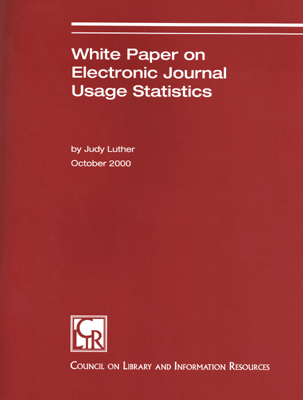White Paper on Electronic Journal Usage Statistics

by Judy Luther
October 2000
Copyright 2000 (Web versions in HTML and PDF are second edition, 2001) by the Council on Library and Information Resources. No part of this publication may be reproduced or transcribed in any form without permission of the publisher. Requests for reproduction should be submitted to the Director of Communications at the Council on Library and Information Resources.
Issues Affecting Librarians and Publishers
- Issues of Common Concern to Librarians and Publishers
- Library Issues
- Publisher Issues
- What Are We Measuring?
- Data Reliability
Appendixes
About the Author
Judy Luther is president of Informed Strategies, a consulting firm in Ardmore, Pennsylvania. Ms Luther specializes in researching and developing new products and companies, and introducing them to the library market. She has worked in the information field for 30 years and holds master’s degrees in library science and in business administration. Her business experience includes 12 years in sales, sales management, and product development at Faxon and ISI. In her 13 years of library experience, she has held positions at Embry-Riddle Aeronautical University and Stetson University. Ms. Luther is active in program planning with the North American Serials Interest Group, the Society for Scholarly Publishers, and the American Library Association. Her articles frequently appear in Information Today, Against the Grain, and the Charleston Advisor.
Acknowledgments
The author wishes to thank the Council on Library and Information Resources, and particularly Deanna Marcum, for supporting this project. This white paper required the involvement of both librarians and publishers who spent considerable time contributing their ideas, explaining developments and technology, and exploring the issues. They include Denise Davis at the National Commission on Libraries and Information Science; Martha Kyrillidou at the Association of Research Libraries; Tom Peters at the Committee for Institutional Cooperation; Tom Sanville at OhioLINK; Michele Newberry at the Florida Center for Library Automation; Rick Luce at Los Alamos National Labs; Arnold Hirshon at NELINET; Charles Lowry at the University of Maryland; Sue Phillips at the University of Texas at Austin; Jill Emery at the University of Texas at Arlington; Louise Green and Jim Mullins at Villanova University; Tom Gilson at the College of Charleston; Christian Boissonnas at Cornell University; Kent Mulliner at Ohio University; Fannie Cox and Weilung Liu at the University of Louisville; Stephen Wiberley and Debbie Blecic at the University of Illinois-Chicago; Judith Hiott at the Houston Public Library; Chrysanne Lowe and Taissa Kusma at Academic Press; Kristen Garlock and Kevin Guthrie at JSTOR; Jim McGinty at Cambridge Scientific Abstracts; Simon Inger and Kirsty Meddings at Catchword; Bernard Rous at the Association of Computing Machinery; Doug LaFrenier at the American Institute of Physics; Adam Chesler at Kluwer; Karen Hunter, John Carroll, and Marthyn Borghuis at Elsevier; Bridget Pairaudeau and Lloyd Fletcher at the Institute of Physics; and Dominic Martinez at MCB University Press.
Preface
Electronic journals represent a significant and growing part of the academic library’s offerings. As demand for e-journals increases, librarians are faced with a new set of decisions related to acquisitions and services. Must libraries retain both print and electronic copies? Is the price of the electronic copy justified by its use? Do usage patterns show that some journals will be as heavily used-or more so-in 20 years as when they are published? Answers to these and other questions require statistics on usage, and in the electronic realm, such statistics must come from the publishers.
Unfortunately, it has been difficult, if not impossible, for librarians to obtain meaningful usage data from publishers of electronic journals. The reason is not a simple matter of publishers being unwilling to provide such information, even though some complain that implementing a data collection function is costly and others fear that librarians will cancel subscriptions if they learn that usage is low. A more basic problem is that there is no agreement on how to produce data that can be compared and analyzed. It has been exceedingly difficult for librarians to know what to ask for when something as basic as the term “use” can have many meanings.
CLIR commissioned Judy Luther to review how and what statistics are currently collected and to identify the issues that must be resolved before librarians and publishers feel comfortable with the data and confident in using them. In her extensive interviews with librarians and publishers, the author found significant common ground on the types of concerns held.
We hope that, in identifying some of the critical issues, this white paper will provide a basis for discussion among publishers, librarians, and aggregators that will lead to effective cooperation in collecting and analyzing usage statistics. CLIR will continue to pursue the agendas that librarians and publishers share as they make the transition to the digital environment and they find new ways of meeting users’ needs.
Deanna Marcum
President

